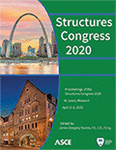Structures Congress 2020
Seismic Performance of Steel Frame Systems with Post-Tensioned Jointed Rocking Connections with Replaceable Structural Fuses Subjected to Mainshock-Aftershock Sequences
Publication: Structures Congress 2020
ABSTRACT
The current state of practice for seismic design of typical buildings consider only a single design level event. The recent 2010–2011 Christchurch earthquake sequences have shown the devastating effects of sequential strong ground motion events for building structures that have not been repaired post-mainshock (MS). These events highlight the need for building structures that can be rapidly repaired while also showing the critical need to consider the seismic response of these structures for cascading large seismic events, when post-MS repairs have not occurred prior to a large aftershock(s) (AS). In recent years there has been a high interest in the development of alternative seismically resilient seismic-force resisting systems (SFRSs) that offer self-centering and rapid reparability characteristics. However, compared to conventional SFRSs, these alternative SFRSs are potentially more vulnerable to large MS-AS sequences as the energy dissipation of the replaceable structural fuses are typically substantially less than those used in conventional SFRSs. Although seismically resilient SFRSs have shown to provide excellent performance under a single design level MS, their seismic performance under cascading large earthquake sequences is not well understood. This paper presents nonlinear response history analyses results of the seismic performance of two distinctly different seismically resilient SFRSs that are expected to provide frame recentering and concentrate inelastic damage to only the replaceable structural fuses. Specifically, one frame system is detailed with post-tensioned beam-to-column joints that rock about the top flanges only with a steel plate infill web plate structural fuses. The second system is detailed with post-tensioned beam-to-column joints that rock about the top and bottom flanges with tension-compression steel structural fuses. The results presented provides some insight on the system performance and seismic resiliency of these alternative SFRSs under large MS-AS sequences.
Get full access to this article
View all available purchase options and get full access to this chapter.
REFERENCES
ASCE (2010). “Minimum Design Loads for Buildings and Other Structures.” ASCE/SEI 7-10. American Society of Civil Engineers, Reston, VA.
Båth, Markus (1965) “Lateral inhomogeneities in the upper mantle,” Tectonophysics 2: 483–514. Bibcode:1965Tectp.2.483B.
Christopoulos, C., Filiatrault, A., Uang, C.M., and Folz, B. (2002). “Posttensioned Energy Dissipating Connections for Moment-Resisting Steel Frame.” Journal of Structural Engineering, ASCE, Vol. 128, No. 9, pp. 1111-1120.
Dowden, D.M., and Bruneau, M. (2016a) “Dynamic Shake-Table Testing and Analytical Investigation of Self-Centering Steel Plate Shear Walls” Journal of Structural Engineering, ASCE.
Dowden, D.M., and Bruneau, M. (2016b) “Kinematics of Self-Centering Steel Plate Shear Walls with NewZ-BREAKSS Post-tensioned Rocking Connection.” Engineering Journal, AISC, Third Quarter, pp. 117-135.
Dowden, D.M., and Bruneau, M. (2019) “Quasi-Static Cyclic Testing and Analytical Investigation of Steel Plate Shear Walls with Different Post-Tensioned Beam-to-Column Rocking Connections.” Engineering Structures.
Dunbar, W. Scott, and Robin G. Charlwood. "Empirical methods for the prediction of response spectra." Earthquake Spectra 7.3 (1991): 333-353.
FEMA State of the Art Report on Systems Performance of Steel Moment Frames Subject to Earthquake Ground Shaking. Rep. No. 355c, SAC Joint Venture for the Federal Emergency Management Agency, Washington, D.C. 2000.
FEMA, Quantification of building seismic performance factors: FEMA P695. 2009, Federal Emergency Management Agency.
Goda, Katsuichiro. “Nonlinear response potential of mainshock–aftershock sequences from Japanese earthquakes.” Bulletin of the Seismological Society of America 102.5 (2012): 2139-2156.
Han, Ruilong, Yue Li, and John van de Lindt. “Assessment of seismic performance of buildings with incorporation of aftershocks.” Journal of Performance of Constructed Facilities 29.3 (2014): 04014088.
Khanmiri, Negar Nazari. Methodology and applications for integrating earthquake aftershock risk into performance-based seismic design. Diss. Colorado State University, 2015.
Li, Quanwang, and Bruce R. Ellingwood. “Performance evaluation and damage assessment of steel frame buildings under main shock–aftershock earthquake sequences.” Earthquake engineering structural dynamics 36.3 (2007): 405-427.
Li, Yue, Ruiqiang Song, and John W. Van De Lindt. “Collapse fragility of steel structures subjected to earthquake mainshock-aftershock sequences.” Journal of Structural Engineering 140.12 (2014): 04014095.
Purba, R., and Bruneau, M. (2014). “Seismic Performance of Steel Plate Shear Walls Considering Various Design Approaches.” Tech. Rep. MCEER-14-0005, Multidisciplinary Center for Earthquake Engineering Research, State University of New York Buffalo, Buffalo, New York.
Rinaldin, Giovanni, Claudio Amadio, and Massimo Fragiacomo. “Effects of seismic sequences on structures with hysteretic or damped dissipative behaviour.” Soil Dynamics and Earthquake Engineering 97 (2017): 205-215.
Ruiz-García, Jorge. “Mainshock-aftershock ground motion features and their influence in building’s seismic response.” Journal of Earthquake Engineering 16.5 (2012): 719-737.
S. Mazzoni, F.M., M.H. Scott, G.L. Fenves, Open system for earthquake engineering simulation user command-language manual – OpenSees version 3.03. 2009, Pacific Earthquake Engineering Research Center, University of California, Berkeley: Berkeley, CA.
SL Kramer “Geotechnical Earthquake Engineering” Prentice Hall (1996)
Uriz, Patxi, Filip C. Filippou, and Stephen A. Mahin “Model for cyclic inelastic buckling of steel braces.” Journal of structural engineering 134.4 (2008): 619-628.
Venture, SAC Joint. “State of the art report on systems performance of steel moment frames subject to earthquake ground shaking.” FEMA 355C (2000).
Wang, D., and Filiatrault, A. (2008). “Numerical and Experimental Studies of Self-Centering Post-tensioned Steel Frames.” Tech. Rep. MCEER-08-0017, Multidisciplinary Center for Earthquake Engineering Research, State University of New York Buffalo, Buffalo, New York.
Yeo, G., Cornell, A (2009) “A Probabilistic Framework for Quantification of Aftershock Ground-Motion Hazard in California: Methodology and Parametric Study,” Earthquake Engineering and Structural Dynamics; 38(1):45-60.
Information & Authors
Information
Published In
ISBN (Online): 978-0-7844-8289-6
Copyright
© 2020 American Society of Civil Engineers.
History
Published online: Apr 2, 2020
Published in print: Apr 2, 2020
Authors
Metrics & Citations
Metrics
Citations
Download citation
If you have the appropriate software installed, you can download article citation data to the citation manager of your choice. Simply select your manager software from the list below and click Download.
